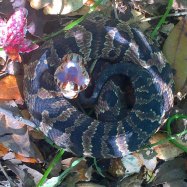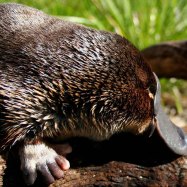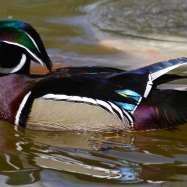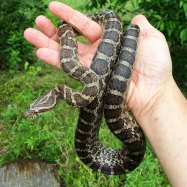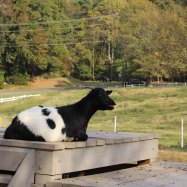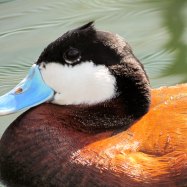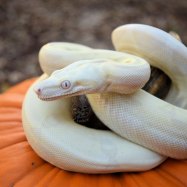
Nova Scotia Duck Tolling Retriever
45-52 cm
The Nova Scotia Duck Tolling Retriever is a medium-sized dog breed known for its intelligence and playful nature. Originating from the province of Nova Scotia, Canada, they are part of the Canidae family and have a length of 45-52 cm. Their unique name comes from their ability to lure and retrieve waterfowl during hunting trips. These loyal and energetic dogs make great companions for outdoor adventures.
Animal Details Summary:
Common Name: Nova Scotia Duck Tolling Retriever
Kingdom: Animalia
Habitat: Wetlands, lakes, rivers
The Beautiful and Talented Nova Scotia Duck Tolling Retriever: A Versatile Hunter of the Canadian Wetlands
The lush wetlands, lakes, and rivers of Canada are home to a diverse array of wildlife. Among these animals is a beloved and talented breed of dog, the Nova Scotia Duck Tolling Retriever. Known for their beautiful red and orange coat and medium-sized body, these dogs are a popular sight for many Canadians. But there is much more to these retrievers than just their stunning appearance Nova Scotia Duck Tolling Retriever.Native to Nova Scotia, Canada, the Nova Scotia Duck Tolling Retriever, also known as Toller for short, is a skilled hunting dog with a long and fascinating history. Let's dive deeper into the world of this versatile and intelligent canine companion.
The DNA and Physical Characteristics of the Toller
Scientifically known as Canis lupus familiaris, the Nova Scotia Duck Tolling Retriever falls under the order Carnivora and the family Canidae. They belong to the same species as domestic dogs, Canis lupus familiaris, but have become a distinct breed with unique traits through selective breeding.Visually, Tollers have a striking appearance with their bright red or orange coat, white markings on their face, chest, and paws, and their comfortably medium-sized body, measuring between 45-52 cm in length. Their coat is water-repellent, enabling them to withstand the Canadian wetlands' cold and damp conditions with ease. These physical characteristics make it no surprise why they have become a popular choice for hunting and sporting dogs in Canada.
A Versatile Hunter and Companion
As their name suggests, the primary role of a Nova Scotia Duck Tolling Retriever is duck hunting. They have excellent retrieving skills, and their compact size allows them to navigate through the marshes and retrieve birds with ease Northern Pintail. But contrary to what their name implies, they do not toll (lure) ducks like some other breeds of retrievers. Instead, they use their energy and agility to retrieve ducks from the water or bring them back to the hunters.But hunting is not the only field where Tollers excel. They are also highly trainable and make excellent therapy and service dogs. Their intelligence, versatility, and adaptability make them ideal for various tasks, from search and rescue to obedience training and agility competitions. They are also known for their gentle and friendly nature, making them great family pets.
A Fascinating History of the Toller
The origins of the Nova Scotia Duck Tolling Retriever can be traced back to the 19th century in the Canadian province of Nova Scotia. Fishermen and hunters in this region needed a highly skilled hunting dog that could work in the harsh, cold, and wet conditions of the Canadian wetlands. They needed a dog that could retrieve game in the water, and that's how the Toller was created.The early Tollers were bred by crossing local working dogs with retrievers, spaniels, and setters. This selective breeding resulted in a versatile hunting dog with exceptional retrieving skills, a strong work ethic, and a love for the water. Over the years, the breed gained popularity, and in 1945 the Canadian Kennel Club officially recognized them as a distinct breed. However, it wasn't until 2003 that the American Kennel Club recognized them as a breed in the United States.
The Toller's Natural Habitat and Feeding Habits
As their name suggests, the Nova Scotia Duck Tolling Retriever is well-adapted to life in and around the water. The wetlands, lakes, and rivers of Canada are their natural habitat, where they can put their hunting skills to the test. Their double coat, consisting of a soft and dense undercoat and a longer waterproof outer coat, provides excellent insulation, keeping them warm and dry in the cold waters.The Tollers' diet mainly consists of meat, which is typical of most carnivorous animals. They are natural hunters and have a strong prey drive, so providing them with a high-quality and balanced diet is crucial for their health and energy levels. Owners should ensure that their Toller gets enough protein and fat intake to support their active lifestyle. As always, it's essential to consult a veterinarian for dietary advice specific to your dog's needs.
The Canadian Country of Origin
The Nova Scotia Duck Tolling Retriever is a Canadian breed, with Nova Scotia as its birthplace. The breed was officially recognized by the Canadian government in the early 20th century and later by the Canadian Kennel Club in 1945. However, their popularity has spread globally, and they are now recognized and loved in many countries worldwide.Training and Grooming Tips for Tollers
Due to their high intelligence, the Toller is a quick learner and responds well to positive reinforcement training methods. However, like any other breed, they require early socialization and obedience training to ensure that they grow up to be well-behaved and well-mannered companions. This training also helps to channel their energy and prevent any destructive behaviors.With their thick and waterproof coat, Tollers require regular grooming to keep their coat in good condition. Brushing at least once a week is essential to remove any dead hair and keep it tangle-free. They also need occasional baths, but special care must be taken to use a shampoo that does not strip them of their natural oils.
A Toller's Life Expectancy and Health Concerns
The average lifespan of a Nova Scotia Duck Tolling Retriever is between 12-14 years. However, like all breeds, they are prone to certain health conditions that owners should be aware of. Some of the common health concerns of Tollers include hip and elbow dysplasia, progressive retinal atrophy, and autoimmune diseases.Like with any pet, regular visits to the veterinarian can help catch any potential health issues early and provide timely treatment. It is also essential to ensure that your Toller receives all necessary vaccinations and preventive care, such as regular tick and flea treatments.
In Conclusion
The Nova Scotia Duck Tolling Retriever is a versatile and beloved breed in Canada and around the world. With their beautiful appearance and skillful hunting abilities, they have rightfully gained a place in the hearts and homes of many. From hunting birds in the Canadian wetlands to being loving and loyal companions, the Toller has proven to be an all-around exceptional breed.Their history, physical characteristics, and unique abilities make them a fascinating subject to study and learn about. They are more than just a pretty face, but a hardworking and intelligent breed that is sure to capture the hearts of many for years to come.

Nova Scotia Duck Tolling Retriever
Animal Details Nova Scotia Duck Tolling Retriever - Scientific Name: Canis lupus familiaris
- Category: Animals N
- Scientific Name: Canis lupus familiaris
- Common Name: Nova Scotia Duck Tolling Retriever
- Kingdom: Animalia
- Phylum: Chordata
- Class: Mammalia
- Order: Carnivora
- Family: Canidae
- Habitat: Wetlands, lakes, rivers
- Feeding Method: Carnivorous
- Geographical Distribution: Canada
- Country of Origin: Canada
- Location: Nova Scotia
- Animal Coloration: Red, orange
- Body Shape: Medium-sized
- Length: 45-52 cm

Nova Scotia Duck Tolling Retriever
- Adult Size: Medium
- Average Lifespan: 12-14 years
- Reproduction: Sexual
- Reproductive Behavior: Monogamous
- Sound or Call: Barking, whimpering
- Migration Pattern: Non-migratory
- Social Groups: Pack
- Behavior: Intelligent, active, friendly
- Threats: None
- Conservation Status: Not endangered
- Impact on Ecosystem: N/A
- Human Use: Hunting, companion
- Distinctive Features: Red coat, white markings, webbed feet
- Interesting Facts: Originally bred for hunting waterfowl
- Predator: None

Canis lupus familiaris
The Fascinating World of the Nova Scotia Duck Tolling Retriever
The canine world is full of unique and beautiful breeds, each with its own set of characteristics and features. Among these breeds is the Nova Scotia Duck Tolling Retriever, a medium-sized dog with a stunning red coat and white markings. While this breed may not be as well-known as some others, it certainly has a fascinating history and distinct traits that make it stand out. In this article, we will delve into the world of the Nova Scotia Duck Tolling Retriever, exploring its origins, behaviors, and its impact on the ecosystem PeaceOfAnimals.Com.Origins and Appearance
The Nova Scotia Duck Tolling Retriever, also known as Toller, is a breed that originated in Canada in the early 19th century. They were originally bred by hunters in the province of Nova Scotia to lure and retrieve waterfowl. They are thought to be a mix of various breeds, including Golden Retrievers, Irish Setters, and native Canadian breeds such as the Nova Scotia Duck-Tolling retriever. Their webbed feet and waterproof coat make them excellent hunters in wet and icy conditions.
The Toller has a distinctive appearance that makes it stand out from other retriever breeds. They have a medium-sized body, usually weighing between 37-51 pounds, and standing at 17-21 inches tall at the shoulder. Their most striking feature is their bright red coat, which is usually accompanied by white markings on the face, chest, and feet. Their eyes are usually a warm shade of amber, and their tail is thick and fluffy, often carried high with a slight curve.
Personality and Behavior
The Toller's personality can be described as intelligent, active, and friendly Nyala. Bred to work closely with their owners, they are highly trainable and excel in various canine activities and sports such as agility, obedience, and dock diving. They are also exceptional working dogs, often used in search and rescue operations.
This breed is known to be very affectionate and loves human companionship. They are devoted and loyal to their families and have a strong bond with their owners. Tollers are not suitable for those looking for a dog that can be left alone for long periods, as they thrive on interaction and attention from their human companions.
In terms of reproductive behavior, Tollers are monogamous and will remain loyal to their chosen mate for life. They are also highly protective of their pack, making them excellent watchdogs. However, their gentle nature and friendly demeanor also make them ideal family pets, especially for households with children.
Sound and Call
As a hunting breed, Tollers are known for their distinct barks and whimpers. They use these sounds to mimic the calls of prey, luring them towards the hunter's gun range. This technique is known as "tolling," which is where the breed's name comes from. Tollers also have a high-pitched scream-like bark, which they use to signal they have found their catch.
Social Groups and Migration Patterns
In the wild, Nova Scotia Duck Tolling Retrievers live in packs, just like most wild canines. However, as domesticated dogs, they adapt to a human-led pack, making them highly social creatures. They enjoy the company of both humans and other dogs, making them an excellent choice for families with multiple pets.
Unlike waterfowl, Tollers are non-migratory, and they usually live in their hunting territories all year round. However, they may migrate to other areas if conditions become unfavorable or food sources are scarce.
Impact on the Ecosystem and Threats
As domesticated dogs, Tollers do not pose any threat to the ecosystem. However, their wild and hunting instincts can be traced back to their ancestors, who played a significant role in controlling waterfowl populations in Nova Scotia. This function greatly benefited the ecosystem, ensuring the balance of various species.
In terms of threats, this breed is not known to face any specific dangers. Being a relatively healthy breed with no known hereditary diseases, Tollers have a lifespan of 12-14 years, which is considered average for medium-sized dogs.
Human Use and Conservation Status
In the 19th century, Nova Scotia Duck Tolling Retrievers were mainly used for hunting waterfowl. Today, they are still used as hunting companions, especially in areas where hunting is still allowed. However, their friendly and sociable nature also makes them great companion dogs, and many owners have Tollers as their beloved pets.
Fortunately, Tollers are not a threatened breed, and their population numbers are stable. This is due to responsible breeding practices and the strict regulations in place for hunting activities that involve using Tollers. As such, the Nova Scotia Duck Tolling Retriever is not considered an endangered breed.
Interesting Facts
Apart from their impressive hunting skills and unique features, Tollers also have some interesting facts that make them stand out among other breeds. Here are some fascinating tidbits about them:
- Tollers are known as the smallest retriever breed.
- They were officially recognized by the Canadian Kennel Club in 1945 and the American Kennel Club in 2003.
- Tollers are the only breed that tolls, using their barks and whimpers to lure prey.
- They have a double coat, with a soft undercoat and a thicker, water-resistant outer coat.
- Tollers are often referred to as "the dog that laughs" due to their high-pitched, joyful barks.
- They are excellent swimmers and enjoy retrieving objects from water.
- Tollers have webbed feet, which aid in swimming and walking on wet and soft surfaces.
Conclusion
The Nova Scotia Duck Tolling Retriever is an impressive breed with a rich history and unique traits that make them stand out among other breeds. From their hunting skills to their loyal and friendly nature, Tollers make excellent companions for both hunting and as family pets. As a domesticated breed, they do not pose any threat to the ecosystem and are not considered endangered. So, if you are looking for a sociable, active, and intelligent dog with a stunning red coat and a joyful bark, the Nova Scotia Duck Tolling Retriever might just be the perfect match for you.
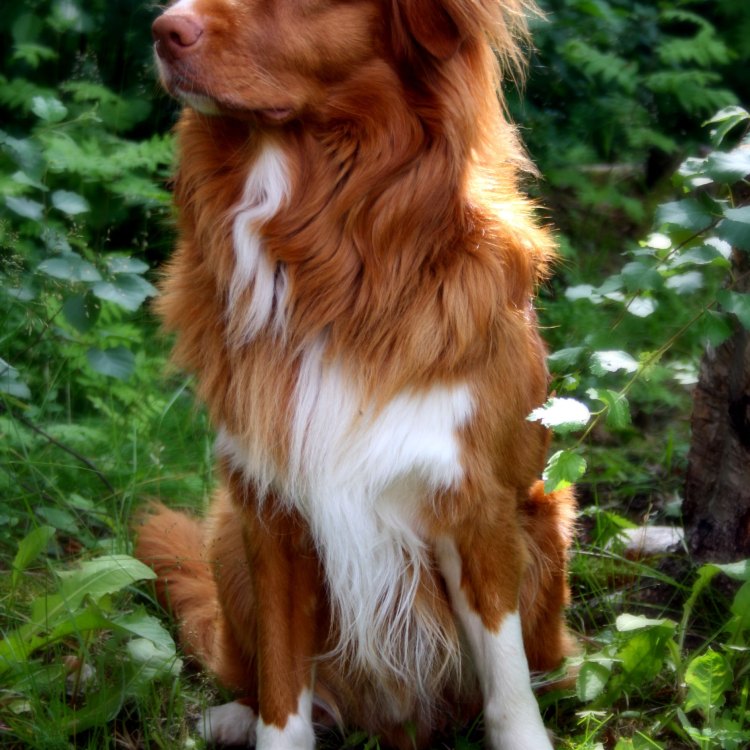
The Beautiful and Talented Nova Scotia Duck Tolling Retriever: A Versatile Hunter of the Canadian Wetlands
Disclaimer: The content provided is for informational purposes only. We cannot guarantee the accuracy of the information on this page 100%. All information provided here may change without prior notice.

